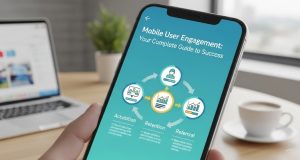The Definitive Guide to Mobile Content Marketing

Now that there is a smartphone in nearly every pocket, businesses can no longer function without considering how their content looks and performs on mobile. Mobile content marketing is not a fad, but a necessity for any business wishing to survive in the digital era.
To ensure that you have the whole picture of mobile content marketing, and not just some isolated sections here or there, this guide will walk you through everything you need—from what it is to how to do.
What’s So Great about Mobile Content Marketing

Mobile content marketing starts by producing and optimizing content to work on smartphones and tablets. The move to mobile is inexorable:
-
From the year 2023, mobile accounts for 58.99% of total website traffic around the world.
-
Americans spend an average 4 hours 46 minutes each day on their mobile devices.
-
Over 70% of consumers prefer browsing websites with their phones to a desktop computer such as those from ASUS.
Fail to adapt your content for mobile users and you’re missing out on a huge audience that values convenience and accessibility. On top of all that, search engines have now moved to mobile-first indexing, meaning sites designed for mobile will show up higher in searches than those that are not.
This guide to mobile content marketing puts everything into fresh perspective, including how mobile differs from desktop.
Key Differences in Mobile Usage
Attention
Users of mobile devices want information quick! They go in short, sharp bursts—on the train, waiting in line, or during commercials. Your content has to be attention-grabbing right away.
Screen Size
Because of screen limitations, your content must be concise and visually appealing. Long passages, tiny fonts, or unoptimized visual elements will frustrate users.
Interactivity
On mobile devices, people interact differently than on computers. They swipe, pinch to zoom, and tap. Content that promotes interactivity—polls, swipes, videos—often outperforms other forms of media.
Top Strategies for Effective Mobile Content Marketing
1. Prioritize Responsive Design
Your website or app should automatically adapt to the screen it’s being viewed on. A responsive design improves user experience and SEO rankings.
Tools like Google’s Mobile-Friendly Test can help ensure your site meets mobile usability standards.
2. Use Simpler, Scannable Formats
Mobile users skim content. Make your content easy to digest by using:
-
Bullet Points for easy reading.
-
Short Paragraphs of 2–3 sentences.
-
Chunking Information into digestible sections.
-
Subheadings to guide the eye through the page.
3. Leverage Visuals
On mobile, visuals are king. Use:
-
Compressed images for faster loading.
-
Subtitled videos since many watch with sound off.
-
Vertical formats (e.g., Reels, TikToks) to boost engagement.
4. Optimize Page Speed
If your mobile site takes too long to load, people will leave. Improve speed by:
-
Compressing images and videos.
-
Minimizing redirects.
-
Leveraging browser caching.
According to Google, over 50% of users leave if a mobile page takes more than 3 seconds to load.
5. Focus on Local SEO
Many mobile searches are local. To improve local SEO:
-
Create a Google My Business profile.
-
Use location-based keywords (e.g., “best coffee shop in downtown Seattle”).
6. Use Mobile-Conducive Formats
Engage mobile users with:
-
Polls & Quizzes – Combat user burnout and increase click-through rates.
-
Stories – Share updates on platforms like Instagram, Facebook, and LinkedIn.
-
Live Streams – Great for product demos and live Q&A sessions.
7. Make Calls to Action Clear and Actionable
Use bold CTA buttons like:
-
“Sign Up Now”
-
“Get Your Free Trial”
-
“Start Shopping”
Ensure buttons are large enough for thumb tapping.
Mobile Content Marketing Bonuses

1) Starbucks
Their mobile app simplifies ordering, offers location-based services, and rewards members with exclusive deals.
2) BuzzFeed
Known for fast-loading listicles and quizzes—perfect for mobile attention spans.
3) Nike
Combines commerce with fitness. Push notifications deliver personalized content, updates, and flash sales.
Measuring Mobile Content Marketing Success
Track these metrics:
-
Mobile Traffic – Use Google Analytics to track visits from mobile.
-
Click-Through Rate (CTR) – Know which CTAs drive engagement.
-
Bounce Rate – High rates may indicate poor mobile design.
-
Conversion Rate – Track sign-ups, purchases, or other goals from mobile users.
Mobile-First Future for Content Marketing
In today’s world, content must be mobile-first to survive. By providing fast, visually-rich, engaging mobile content, you’ll not only keep up—you’ll stay ahead.
Now is the time to make your content mobile-first. Focus on delivering fast, engaging, and visually-rich experiences that resonate with your audience. The future of content marketing is mobile, and you are ready for it!






